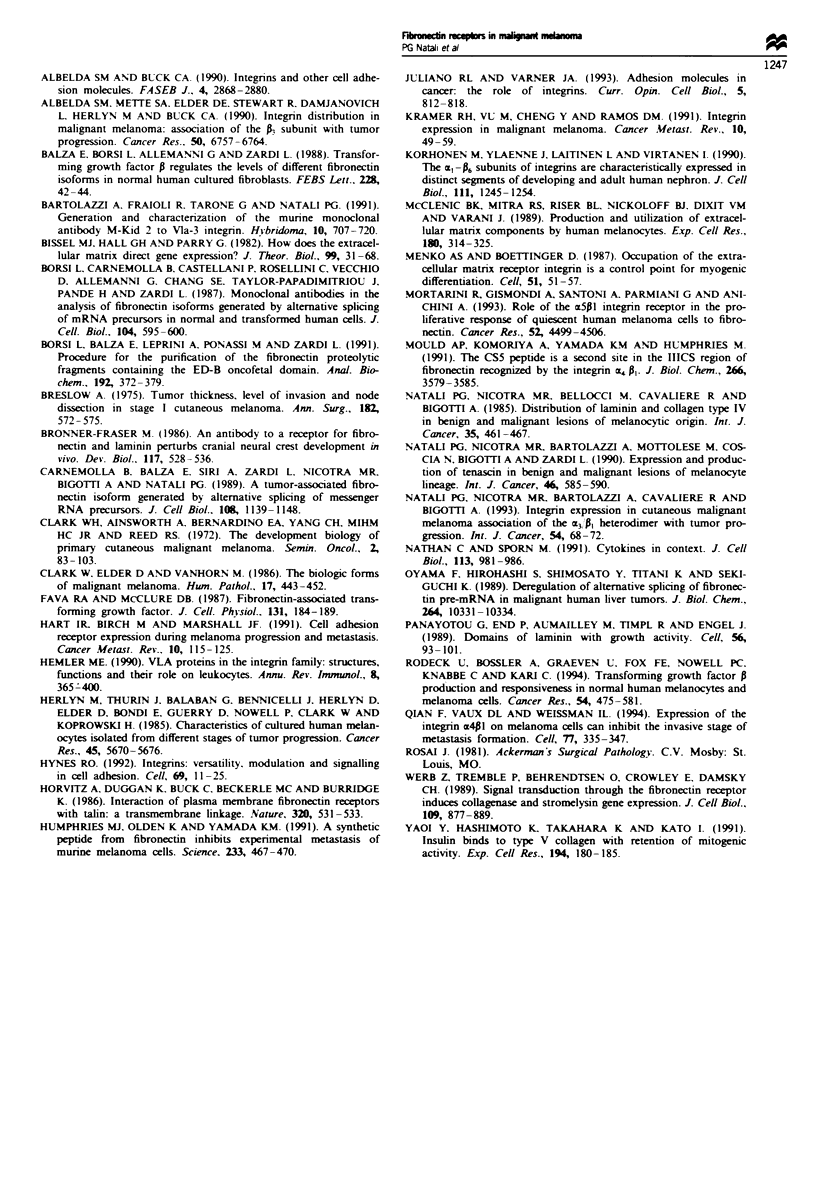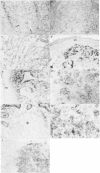Abstract
In vitro studies have demonstrated that fibronectin (FN) can deliver a mitogenic signal to quiescent human melanoma cells and that the alpha 5/beta 1-integrin receptor mediates this stimulus. In view of this finding we have analysed the in vivo expression of FN, and of ED-A and ED-B FN isoforms, in benign and malignant lesions of melanocyte origin. In the same specimens the expression of fibronectin integrin receptors was evaluated. The results demonstrate that, while detection of FN does not correlate with transformation and tumour progression, the expression of the two isoforms is associated with transformation and that only the ED-A variant is found in metastases. Integrin phenotyping disclosed that alpha 3/beta 1 expression is associated with tumour progression, alpha v/beta 3 is a marker of transformation, alpha 4 is rarely expressed and alpha 5 is expressed by about 50% and 30% of the primary and metastatic lesions respectively. Taken together, the results of this study demonstrate that transformation and tumour progression of the melanocyte lineage are associated with modulation of expression of FN isoforms and FN integrin receptors. Furthermore, the expression of alpha 5-integrin in a considerable percentage of primary and metastatic lesions indicates that FN may deliver a proliferative stimulus to melanoma cells in vivo.
Full text
PDF




Images in this article
Selected References
These references are in PubMed. This may not be the complete list of references from this article.
- Adams J. C., Watt F. M. Changes in keratinocyte adhesion during terminal differentiation: reduction in fibronectin binding precedes alpha 5 beta 1 integrin loss from the cell surface. Cell. 1990 Oct 19;63(2):425–435. doi: 10.1016/0092-8674(90)90175-e. [DOI] [PubMed] [Google Scholar]
- Albelda S. M., Buck C. A. Integrins and other cell adhesion molecules. FASEB J. 1990 Aug;4(11):2868–2880. [PubMed] [Google Scholar]
- Albelda S. M., Mette S. A., Elder D. E., Stewart R., Damjanovich L., Herlyn M., Buck C. A. Integrin distribution in malignant melanoma: association of the beta 3 subunit with tumor progression. Cancer Res. 1990 Oct 15;50(20):6757–6764. [PubMed] [Google Scholar]
- Albelda S. M. Role of integrins and other cell adhesion molecules in tumor progression and metastasis. Lab Invest. 1993 Jan;68(1):4–17. [PubMed] [Google Scholar]
- Balza E., Borsi L., Allemanni G., Zardi L. Transforming growth factor beta regulates the levels of different fibronectin isoforms in normal human cultured fibroblasts. FEBS Lett. 1988 Feb 8;228(1):42–44. doi: 10.1016/0014-5793(88)80580-5. [DOI] [PubMed] [Google Scholar]
- Bartolazzi A., Fraioli R., Tarone G., Natali P. G. Generation and characterization of the murine monoclonal antibody M-KID 2 to VLA-3 integrin. Hybridoma. 1991 Dec;10(6):707–720. doi: 10.1089/hyb.1991.10.707. [DOI] [PubMed] [Google Scholar]
- Bissell M. J., Hall H. G., Parry G. How does the extracellular matrix direct gene expression? J Theor Biol. 1982 Nov 7;99(1):31–68. doi: 10.1016/0022-5193(82)90388-5. [DOI] [PubMed] [Google Scholar]
- Borsi L., Balza E., Leprini A., Ponassi M., Zardi L. Procedure for the purification of the fibronectin proteolytic fragments containing the ED-B oncofetal domain. Anal Biochem. 1991 Feb 1;192(2):372–379. doi: 10.1016/0003-2697(91)90551-4. [DOI] [PubMed] [Google Scholar]
- Borsi L., Carnemolla B., Castellani P., Rosellini C., Vecchio D., Allemanni G., Chang S. E., Taylor-Papadimitriou J., Pande H., Zardi L. Monoclonal antibodies in the analysis of fibronectin isoforms generated by alternative splicing of mRNA precursors in normal and transformed human cells. J Cell Biol. 1987 Mar;104(3):595–600. doi: 10.1083/jcb.104.3.595. [DOI] [PMC free article] [PubMed] [Google Scholar]
- Breslow A. Tumor thickness, level of invasion and node dissection in stage I cutaneous melanoma. Ann Surg. 1975 Nov;182(5):572–575. doi: 10.1097/00000658-197511000-00007. [DOI] [PMC free article] [PubMed] [Google Scholar]
- Bronner-Fraser M. An antibody to a receptor for fibronectin and laminin perturbs cranial neural crest development in vivo. Dev Biol. 1986 Oct;117(2):528–536. doi: 10.1016/0012-1606(86)90320-9. [DOI] [PubMed] [Google Scholar]
- Carnemolla B., Balza E., Siri A., Zardi L., Nicotra M. R., Bigotti A., Natali P. G. A tumor-associated fibronectin isoform generated by alternative splicing of messenger RNA precursors. J Cell Biol. 1989 Mar;108(3):1139–1148. doi: 10.1083/jcb.108.3.1139. [DOI] [PMC free article] [PubMed] [Google Scholar]
- Clark W. H., Jr, Ainsworth A. M., Bernardino E. A., Yang C. H., Mihm C. M., Jr, Reed R. J. The developmental biology of primary human malignant melanomas. Semin Oncol. 1975 Jun;2(2):83–103. [PubMed] [Google Scholar]
- Clark W. H., Jr, Elder D. E., Van Horn M. The biologic forms of malignant melanoma. Hum Pathol. 1986 May;17(5):443–450. doi: 10.1016/s0046-8177(86)80032-6. [DOI] [PubMed] [Google Scholar]
- Fava R. A., McClure D. B. Fibronectin-associated transforming growth factor. J Cell Physiol. 1987 May;131(2):184–189. doi: 10.1002/jcp.1041310207. [DOI] [PubMed] [Google Scholar]
- Hart I. R., Birch M., Marshall J. F. Cell adhesion receptor expression during melanoma progression and metastasis. Cancer Metastasis Rev. 1991 Jun;10(2):115–128. doi: 10.1007/BF00049409. [DOI] [PubMed] [Google Scholar]
- Hemler M. E. VLA proteins in the integrin family: structures, functions, and their role on leukocytes. Annu Rev Immunol. 1990;8:365–400. doi: 10.1146/annurev.iy.08.040190.002053. [DOI] [PubMed] [Google Scholar]
- Herlyn M., Thurin J., Balaban G., Bennicelli J. L., Herlyn D., Elder D. E., Bondi E., Guerry D., Nowell P., Clark W. H. Characteristics of cultured human melanocytes isolated from different stages of tumor progression. Cancer Res. 1985 Nov;45(11 Pt 2):5670–5676. [PubMed] [Google Scholar]
- Horwitz A., Duggan K., Buck C., Beckerle M. C., Burridge K. Interaction of plasma membrane fibronectin receptor with talin--a transmembrane linkage. Nature. 1986 Apr 10;320(6062):531–533. doi: 10.1038/320531a0. [DOI] [PubMed] [Google Scholar]
- Humphries M. J., Olden K., Yamada K. M. A synthetic peptide from fibronectin inhibits experimental metastasis of murine melanoma cells. Science. 1986 Jul 25;233(4762):467–470. doi: 10.1126/science.3726541. [DOI] [PubMed] [Google Scholar]
- Hynes R. O. Integrins: versatility, modulation, and signaling in cell adhesion. Cell. 1992 Apr 3;69(1):11–25. doi: 10.1016/0092-8674(92)90115-s. [DOI] [PubMed] [Google Scholar]
- Juliano R. L., Varner J. A. Adhesion molecules in cancer: the role of integrins. Curr Opin Cell Biol. 1993 Oct;5(5):812–818. doi: 10.1016/0955-0674(93)90030-t. [DOI] [PubMed] [Google Scholar]
- Korhonen M., Ylänne J., Laitinen L., Virtanen I. The alpha 1-alpha 6 subunits of integrins are characteristically expressed in distinct segments of developing and adult human nephron. J Cell Biol. 1990 Sep;111(3):1245–1254. doi: 10.1083/jcb.111.3.1245. [DOI] [PMC free article] [PubMed] [Google Scholar]
- Kramer R. H., Vu M., Cheng Y. F., Ramos D. M. Integrin expression in malignant melanoma. Cancer Metastasis Rev. 1991 May;10(1):49–59. doi: 10.1007/BF00046843. [DOI] [PubMed] [Google Scholar]
- McClenic B. K., Mitra R. S., Riser B. L., Nickoloff B. J., Dixit V. M., Varani J. Production and utilization of extracellular matrix components by human melanocytes. Exp Cell Res. 1989 Feb;180(2):314–325. doi: 10.1016/0014-4827(89)90060-8. [DOI] [PubMed] [Google Scholar]
- Menko A. S., Boettiger D. Occupation of the extracellular matrix receptor, integrin, is a control point for myogenic differentiation. Cell. 1987 Oct 9;51(1):51–57. doi: 10.1016/0092-8674(87)90009-2. [DOI] [PubMed] [Google Scholar]
- Mortarini R., Gismondi A., Santoni A., Parmiani G., Anichini A. Role of the alpha 5 beta 1 integrin receptor in the proliferative response of quiescent human melanoma cells to fibronectin. Cancer Res. 1992 Aug 15;52(16):4499–4506. [PubMed] [Google Scholar]
- Mould A. P., Komoriya A., Yamada K. M., Humphries M. J. The CS5 peptide is a second site in the IIICS region of fibronectin recognized by the integrin alpha 4 beta 1. Inhibition of alpha 4 beta 1 function by RGD peptide homologues. J Biol Chem. 1991 Feb 25;266(6):3579–3585. [PubMed] [Google Scholar]
- Natali P. G., Nicotra M. R., Bartolazzi A., Cavaliere R., Bigotti A. Integrin expression in cutaneous malignant melanoma: association of the alpha 3/beta 1 heterodimer with tumor progression. Int J Cancer. 1993 Apr 22;54(1):68–72. doi: 10.1002/ijc.2910540112. [DOI] [PubMed] [Google Scholar]
- Natali P. G., Nicotra M. R., Bartolazzi A., Mottolese M., Coscia N., Bigotti A., Zardi L. Expression and production of tenascin in benign and malignant lesions of melanocyte lineage. Int J Cancer. 1990 Oct 15;46(4):586–590. doi: 10.1002/ijc.2910460406. [DOI] [PubMed] [Google Scholar]
- Natali P. G., Nicotra M. R., Bellocci M., Cavaliere R., Bigotti A. Distribution of laminin and collagen type-IV in benign and malignant lesions of melanocytic origin. Int J Cancer. 1985 Apr 15;35(4):461–467. doi: 10.1002/ijc.2910350408. [DOI] [PubMed] [Google Scholar]
- Nathan C., Sporn M. Cytokines in context. J Cell Biol. 1991 Jun;113(5):981–986. doi: 10.1083/jcb.113.5.981. [DOI] [PMC free article] [PubMed] [Google Scholar]
- Oyama F., Hirohashi S., Shimosato Y., Titani K., Sekiguchi K. Deregulation of alternative splicing of fibronectin pre-mRNA in malignant human liver tumors. J Biol Chem. 1989 Jun 25;264(18):10331–10334. [PubMed] [Google Scholar]
- Panayotou G., End P., Aumailley M., Timpl R., Engel J. Domains of laminin with growth-factor activity. Cell. 1989 Jan 13;56(1):93–101. doi: 10.1016/0092-8674(89)90987-2. [DOI] [PubMed] [Google Scholar]
- Qian F., Vaux D. L., Weissman I. L. Expression of the integrin alpha 4 beta 1 on melanoma cells can inhibit the invasive stage of metastasis formation. Cell. 1994 May 6;77(3):335–347. doi: 10.1016/0092-8674(94)90149-x. [DOI] [PubMed] [Google Scholar]
- Rodeck U., Bossler A., Graeven U., Fox F. E., Nowell P. C., Knabbe C., Kari C. Transforming growth factor beta production and responsiveness in normal human melanocytes and melanoma cells. Cancer Res. 1994 Jan 15;54(2):575–581. [PubMed] [Google Scholar]
- Werb Z., Tremble P. M., Behrendtsen O., Crowley E., Damsky C. H. Signal transduction through the fibronectin receptor induces collagenase and stromelysin gene expression. J Cell Biol. 1989 Aug;109(2):877–889. doi: 10.1083/jcb.109.2.877. [DOI] [PMC free article] [PubMed] [Google Scholar]
- Yaoi Y., Hashimoto K., Takahara K., Kato I. Insulin binds to type V collagen with retention of mitogenic activity. Exp Cell Res. 1991 Jun;194(2):180–185. doi: 10.1016/0014-4827(91)90351-t. [DOI] [PubMed] [Google Scholar]



